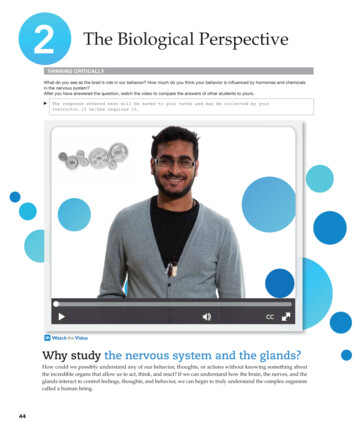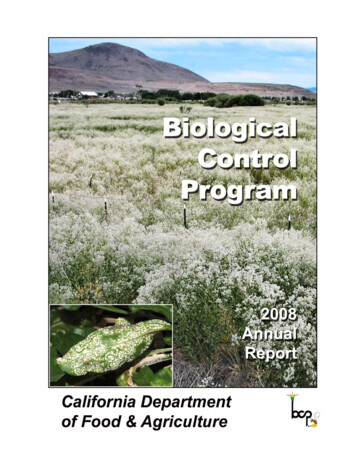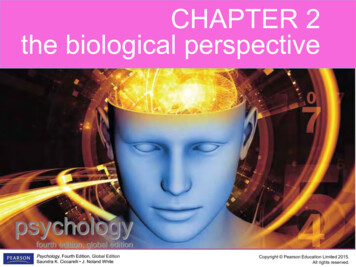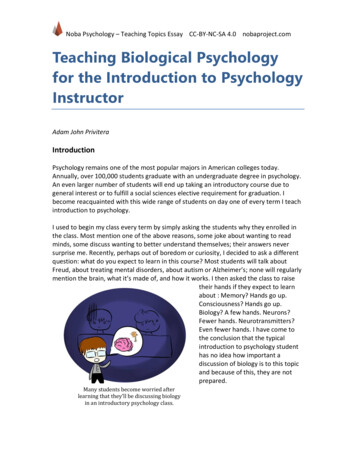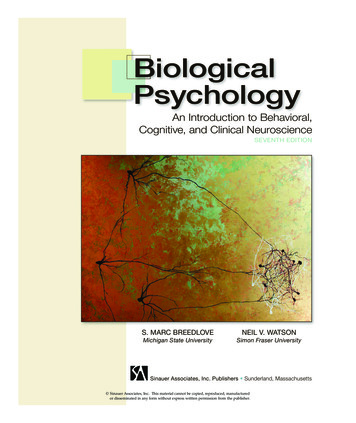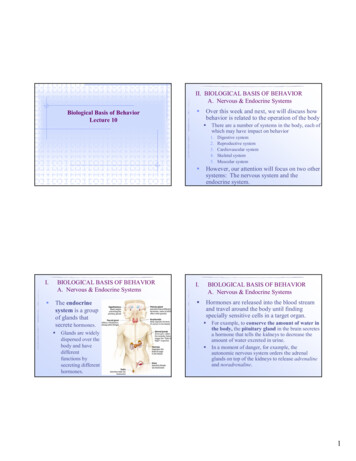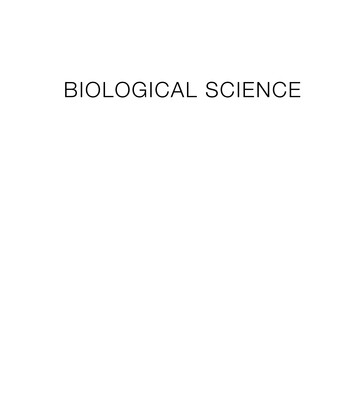
Transcription
BIOLOGICAL SCIENCEA01 FREE8719 02 SE FM.indd i10/30/12 9:24 PM
Red-tailed Hawk, Buteo jamaicensisThe red-tailed hawk searches for a wide varietyof small prey, capturing them by swooping fromthe air or diving from a stationary perch. Buteoslike the red-tailed hawk are adapted for predation,with broad wings and tail for soaring flight, curvedtalons for grasping prey, large forward-rotated eyesfor acute long-distance vision, and a sharp tearingbeak. The red-tailed hawk’s colouration, which isdarker above and paler underneath, camouflagesit from below. The red-tailed hawk’s opportunistichunting skills have helped it to be the most widelydistributed hawk in North America.A01 FREE8719 02 SE FM.indd ii10/30/12 9:24 PM
BIOLOGICAL SCIENCESecond Canadian EditionS C O T T F RE E M ANUniversity of WashingtonM IK E H ARRIN G T O NUniversity of AlbertaJ O AN S H ARPSimon Fraser UniversityTorontoA01 FREE8719 02 SE FM.indd iii10/30/12 9:24 PM
“I would like to dedicate this book to my grandparents, the best teachers one could hope for.”—Mike Harrington“For Yusef, who finds the world a fascinating place, and in memory of Yasmin, who found comfort in nature.”—Joan SharpVice‐President, Editorial Director: Gary BennettSenior Acquisitions Editor: Lisa RahnSenior Marketing Manager: Kim UkrainecSupervising Developmental Editor: Maurice EssesDevelopmental Editor: Joanne SutherlandProject Manager: Rachel ThompsonManufacturing Coordinator: Karen BradleyProduction Editor: Carrie FoxCopy Editor: Audra GorgievProofreader: Dawn AdamsProject Coordination and Editorial Services: Electronic Publishing Services Inc., NYCElectronic Page Makeup: JouvePhoto and Permissions Researcher: Terri RothmanArt Director: Julia HallCover Designer: Anthony LeungInterior Designer: Anthony LeungCover Image: Getty Images/Deborah HarrisonCredits and acknowledgments for material borrowed from other sources and reproduced, with permission, in thistextbook appear on the appropriate page within the text or beginning on page C:1 of the backmatter.Original edition published by Pearson Education, Inc., Upper Saddle River, New Jersey, USA. Copyright 2011Pearson Education, Inc. This edition is authorized for sale only in Canada.If you purchased this book outside the United States or Canada, you should be aware that it has been imported withoutthe approval of the publisher or the author.Copyright 2014 Pearson Canada Inc. All rights reserved. Manufactured in the United States of America. This publicationis protected by copyright and permission should be obtained from the publisher prior to any prohibited reproduction,storage in a retrieval system, or transmission in any form or by any means, electronic, mechanical, photocopying, recording,or likewise. To obtain permission(s) to use material from this work, please submit a written request to Pearson Canada Inc.,Permissions Department, 26 Prince Andrew Place, Don Mills, Ontario, M3C 2T8, or fax your request to 416‐447‐3126, orsubmit a request to Permissions Requests at www.pearsoncanada.ca.10 9 8 7 6 5 4 3 2 1Library and Archives Canada Cataloguing in PublicationFreeman, Scott, 1955-Biological science / Scott Freeman, Mike Harrington, Joan Sharp. — 2nd Canadian ed.ISBN 978-0-321-78871-91. Biology—Textbooks. I. Harrington, Mike, 1968- II. Sharp, Joan Catherine, 1951- III. Title.QH308.2.F73 2012 570 C2012-903875-XISBN 10: 0-321-78871-0ISBN 13: 978‐0‐32‐178871‐9A01 FREE8719 02 SE FM.indd iv10/30/12 9:24 PM
Brief Contents1 Biology and the Tree of Life1UNIT 1 THE MOLECULES OF LIFE 1623456Water and Carbon: The Chemical Basis of Life 16Protein Structure and Function 40Nucleic Acids and the RNA World 62An Introduction to Carbohydrates 75Lipids, Membranes, and the First Cells 87UNIT 2 CELL STRUCTURE AND FUNCTION 1127891011Inside the Cell 112Cellular Respiration and Fermentation 163Photosynthesis 188The Cell Cycle 212Meiosis 232Bacteria and Archaea 546Protists 571Green Algae and Land Plants 599Fungi 635An Introduction to Animals 660Protostome Animals 684Deuterostome Animals 709Viruses 742UNIT 7 HOW PLANTS WORK 7643637383940Plant Form and Function 764Water and Sugar Transport in Plants 788Plant Nutrition 809Plant Sensory Systems, Signals, and Responses 829Plant Reproduction 860Mendel and the Gene 252DNA and the Gene: Synthesis and Repair 281How Genes Work 300Transcription, RNA Processing, and Translation 314Control of Gene Expression in Bacteria 333Control of Gene Expression in Eukaryotes 347Analyzing and Engineering Genes 368Genomics 392UNIT 4 DEVELOPMENTAL BIOLOGY 41021 Principles of Development 41022 An Introduction to Animal Development 42623 An Introduction to Plant Development 440UNIT 5 EVOLUTIONARY PROCESSES AND PATTERNS 455242526272829303132333435Cell–Cell Interactions 143UNIT 3 GENE STRUCTURE AND EXPRESSION 232121314151617181920UNIT 6 THE DIVERSIFICATION OF LIFE 546Evolution by Natural Selection 455Evolutionary Processes 477Speciation 503Phylogenies and the History of Life 521UNIT 8 HOW ANIMALS WORK 883414243444546474849Animal Form and Function 883Water and Electrolyte Balance in Animals 904Animal Nutrition 924Gas Exchange and Circulation 946Electrical Signals in Animals 973Animal Sensory Systems and Movement 996Chemical Signals in Animals 1019Animal Reproduction 1041The Immune System in Animals 1065UNIT 9 ECOLOGY 1088505152535455An Introduction to Ecology 1088Behavioural Ecology 1121Population Ecology 1141Community Ecology 1166Ecosystems 1193Biodiversity and Conservation Biology 1219vA01 FREE8719 02 SE FM.indd v10/30/12 9:24 PM
Detailed ContentsAbout the Authors xxPreface to Instructors xxiPreface to Students: How to Use This Book xxxiv1Biology and the Tree of Life11.1 What Does It Mean to Say That Something Is Alive? 11.2 The Cell Theory 2CANADIAN RESEARCH 2.1 The Carbon-Rich Tagish LakeMeteorite 37CHAPTER REVIEW 383The Structure of Amino Acids 42The Nature of Side Chains 42How Do Amino Acids Link to Form Proteins? 441.3 The Theory of Evolution by Natural Selection 41.4 The Tree of Life 63.3 Proteins Are the Most Versatile Large Molecules inCells 46CANADIAN RESEARCH 3.1 Designing New Proteins 473.4 What Do Proteins Look Like? 47Primary Structure 48Secondary Structure 48Tertiary Structure 49Quaternary Structure 50Using Molecules to Understand the Tree of Life 7How Should We Name Branches on the Tree of Life? 91.5 Doing Biology 9Why Do Giraffes Have Long Necks? An Introduction toHypothesis Testing 9How Do Ants Navigate? An Introduction to Experimental Design 11403.1 Early Origin-of-Life Experiments 413.2 Amino Acids and Polymerization 42Are All Organisms Made of Cells? 2Where Do Cells Come From? 2What Is Evolution? 4What Is Natural Selection? 4CANADIAN RESEARCH 1.1 Artificial Selection on Bighorn Sheepin Alberta 6Protein Structure and FunctionCANADIAN RESEARCH 3.2 Spider Silk Proteins 52Folding and Function 523.5 Enzymes: An Introduction to Catalysis 54Enzymes Help Reactions Clear Two Hurdles 55How Do Enzymes Work? 56Was the First Living Entity a Protein Catalyst? 59CHAPTER REVIEW 13UNIT 1 THE MOLECULES OF LIFE 16CHAPTER REVIEW 602Water and Carbon: The ChemicalBasis of Life 162.1 Atoms, Ions, and Molecules: The Building Blocks ofChemical Evolution 17Basic Atomic Structure 17How Does Covalent Bonding Hold Molecules Together? 18Ionic Bonding, Ions, and the Electron-Sharing Continuum 19Some Simple Molecules Formed from C, H, N, and O 20The Geometry of Simple Molecules 21Representing Molecules 21Basic Concepts in Chemical Reactions 224Could Chemical Evolution Result in the Production ofNucleotides? 63How Do Nucleotides Polymerize to Form Nucleic Acids? 644.2 DNA Structure and Function 65What Is the Nature of DNA’s Secondary Structure? 66DNA Functions as an Information-Containing Molecule 67Is DNA a Catalytic Molecule? 694.3 RNA Structure and Function 69Structurally, RNA Differs from DNA 69RNA’s Structure Makes It an Extraordinarily Versatile Molecule 70RNA Is an Information-Containing Molecule 71RNA Can Function as a Catalytic Molecule 71Why Is Water Such an Efficient Solvent? 23How Does Water’s Structure Correlate with Its Properties? 23Acid–Base Reactions Involve a Transfer of Protons 26How Do Chemical Reactions Happen? 28What Is Energy? 28Chemical Evolution: A Model System 30How Did Chemical Energy Change during Chemical Evolution? 342.4 The Importance of Carbon 34Linking Carbon Atoms Together 35Functional Groups 36624.1 What Is a Nucleic Acid? 622.2 The Early Oceans and the Properties of Water 232.3 Chemical Reactions, Chemical Evolution, andChemical Energy 28Nucleic Acids and the RNA World4.4 The First Life Form 71CANADIAN RESEARCH 4.1 Designing New Deoxyribozymes 72CHAPTER REVIEW 735An Introduction to Carbohydrates755.1 Sugars as Monomers 75How Monosaccharides Differ 76Monosaccharides and Chemical Evolution 76viA01 FREE8719 02 SE FM.indd vi10/30/12 9:24 PM
7.3 Putting the Parts into a Whole 1265.2 The Structure of Polysaccharides 77Starch: A Storage Polysaccharide in Plants 78Glycogen: A Highly Branched Storage Polysaccharide in Animals 78Cellulose: A Structural Polysaccharide in Plants 78Chitin: A Structural Polysaccharide in Fungi and Animals 80Peptidoglycan: A Structural Polysaccharide in Bacteria 80Polysaccharides and Chemical Evolution 805.3 What Do Carbohydrates Do? 80The Role of Carbohydrates as Structural Molecules 81The Role of Carbohydrates in Cell Identity 81The Role of Carbohydrates in Energy Storage 81CANADIAN ISSUES 5.1 Raymond Lemieux and the Synthesis ofSugars 82CANADIAN RESEARCH 5.1 Natural and Artificial Sweeteners 84Structure and Function at the Whole-Cell Level 126The Dynamic Cell 1267.4 Cell Systems I: Nuclear Transport 127Structure and Function of the Nuclear Envelope 127How Are Molecules Imported into the Nucleus? 1287.5 Cell Systems II: The Endomembrane SystemManufactures and Ships Proteins 129Studying the Pathway through the EndomembraneSystem 129Entering the Endomembrane System: The SignalHypothesis 131Moving from the ER to the Golgi 132What Happens inside the Golgi Apparatus? 133How Do Proteins Reach Their Destinations? 133CHAPTER REVIEW 857.6 Cell Systems III: The Dynamic Cytoskeleton 1346Lipids, Membranes, and the First CellsActin Filaments 134Intermediate Filaments 135Microtubules 136CANADIAN RESEARCH 7.2 Pathogenic Bacteria Alter theCytoskeleton of Human Cells 137Flagella and Cilia: Moving the Entire Cell 138876.1 Lipids 88A Look at Three Types of Lipids Found in Cells 88The Structures of Membrane Lipids 896.2 Phospholipid Bilayers 90Artificial Membranes as an Experimental System 90Selective Permeability of Lipid Bilayers 91How Does Lipid Structure Affect Membrane Properties? 92How Does Temperature Affect the Fluidity and Permeability ofMembranes? 93CANADIAN ISSUES 6.1 Lipids in Our Diet: Cholesterol,Unsaturated Oils, Saturated Fats, and Trans Fats 946.3 Why Molecules Move across Lipid Bilayers: Diffusionand Osmosis 96Diffusion 96Osmosis 96CHAPTER REVIEW 1408Evolution of the Fluid-Mosaic Model 99Systems for Studying Membrane Proteins 101Protein Transport I: Facilitated Diffusion via ChannelProteins 102Protein Transport II: Facilitated Diffusion via Carrier Proteins 104Protein Transport III: Active Transport by Pumps 104Plasma Membranes and the Intracellular Environment 1061438.1 The Cell Surface 144The Structure and Function of an Extracellular Layer 144The Cell Wall in Plants 144The Extracellular Matrix in Animals 1458.2 How Do Adjacent Cells Connect andCommunicate? 146Cell–Cell Attachments in Eukaryotes 147Cells Communicate via Cell–Cell Gaps 150CANADIAN RESEARCH 6.1 Liposomal Nanomedicines 986.4 Membrane Proteins 99Cell–Cell Interactions8.3 How Do Distant Cells Communicate? 151Cell–Cell Signalling in Multicellular Organisms 151Signal Reception 152Signal Processing 152CANADIAN RESEARCH 8.1 The Discovery of Insulin 156Signal Response 158Signal Deactivation 158Cross-Talk: Synthesizing Input from Many Signals 158Quorum Sensing in Bacteria 159CANADIAN RESEARCH 8.2 How Do Intracellular Proteins Bindto Receptor Tyrosine Kinases? 160CHAPTER REVIEW 107The Big Picture: Macromolecules 110CHAPTER REVIEW 161UNIT 2 CELL STRUCTURE AND FUNCTION 1127Inside the Cell1127.1 Bacterial and Archaeal Cell Structures and TheirFunctions 112A Revolutionary New View 113Prokaryotic Cell Structures: A Parts List 113CANADIAN RESEARCH 7.1 Bacteria Cells Have Their OwnCytoskeleton 1157.2 Eukaryotic Cell Structures and Their Functions 116The Benefits of Organelles 116Eukaryotic Cell Structures: A Parts List 1179Cellular Respiration and Fermentation9.1 The Nature of Chemical Energy and RedoxReactions 164The Structure and Function of ATP 164What Is a Redox Reaction? 1669.2 An Overview of Cellular Respiration 1689.3 Glycolysis: Processing Glucose to Pyruvate 169Glycolysis Is a Sequence of 10 Reactions 169How Is Glycolysis Regulated? 1709.4 Processing Pyruvate to Acetyl CoA 171DETAILED CONTENTSA01 FREE8719 02 SE FM.indd vii163vii10/30/12 9:24 PM
9.5 The Citric Acid Cycle: Oxidizing AcetylCoA to CO2 17311.2 How Does Mitosis Take Place? 215Proteins Needed for Mitosis 215Cytokinesis Results in Two Daughter Cells 218How Do Chromosomes Move during Mitosis? 218How Is the Citric Acid Cycle Regulated? 173What Happens to the NADH and FADH2? 1739.6 Electron Transport and Chemiosmosis: Buildinga Proton Gradient to Produce ATP 176Components of the Electron Transport Chain 176The Chemiosmosis Hypothesis 177How Is the Electron Transport Chain Organized? 178The Discovery of ATP Synthase 178Organisms Use a Diversity of Electron Acceptors 179CANADIAN RESEARCH 9.1 The ATP Synthase 18011.3 Control of the Cell Cycle 220The Discovery of Cell-Cycle Regulatory Molecules 220CANADIAN RESEARCH 11.1 Yoshio Masui and theDiscovery of MPF 222Cell-Cycle Checkpoints Can Arrest the Cell Cycle 22311.4 Cancer: Out-of-Control Cell Division 225Properties of Cancer Cells 225Cancer Involves Loss of Cell-Cycle Control 226CANADIAN RESEARCH 11.2 A Newly DiscoveredProperty of Cancer Cells 2279.7 Fermentation 181CANADIAN ISSUES 9.1 Making Biofuels with Fermentationand Anaerobic Respiration 1839.8 How Does Cellular Respiration Interact with OtherMetabolic Pathways? 184Catabolic Pathways Break Down Molecules as Fuel 184Anabolic Pathways Synthesize Key Molecules 185CHAPTER REVIEW 185CHAPTER REVIEW 229UNIT 3 GENE STRUCTURE AND EXPRESSION 23212Meiosis23212.1 How Does Meiosis Occur? 23310PhotosynthesisChromosomes Come in Distinct Types 233The Concept of Ploidy 233An Overview of Meiosis 234The Phases of Meiosis I 237The Phases of Meiosis II 238A Closer Look at Prophase I 241CANADIAN RESEARCH 12.1 The Proteins Required forProphase I of Meiosis 24218810.1 Photosynthesis Harnesses Sunlight to MakeCarbohydrate 188Photosynthesis: Two Linked Sets of Reactions 189Photosynthesis Occurs in Chloroplasts 19010.2 How Does Chlorophyll Capture Light Energy? 190Photosynthetic Pigments Absorb Light 191When Light Is Absorbed, Electrons Enter an Excited State 19312.2 The Consequences of Meiosis 242Chromosomes and Heredity 243Independent Assortment Produces Genetic Variation 243A Benefit of Crossing Over 244How Does Fertilization Affect Genetic Variation? 24410.3 The Discovery of Photosystems I and II 195How Does Photosystem II Work? 196How Does Photosystem I Work? 198The Z Scheme: Photosystems II and I Work Together 19812.3 Why Does Meiosis Exist? 245The Paradox of Sex 245The Purifying Selection Hypothesis 245The Changing-Environment Hypothesis 24610.4 How Is Carbon Dioxide Reduced to ProduceGlucose? 200The Calvin Cycle Fixes Carbon 201The Discovery of Rubisco 202Carbon Dioxide Enters Leaves through Stomata 203Mechanisms for Increasing CO2 Concentration NearRubisco 204How Is Photosynthesis Regulated? 205What Happens to the Sugar That Is Produced byPhotosynthesis? 205CANADIAN RESEARCH 10.1 Turning C3 Plants into C4Plants 206CHAPTER REVIEW 207The Big Picture: Energy for Life 21011The Cell Cycle21211.1 Mitosis and the Cell Cycle 213What Is a Chromosome? 213Cells Alternate between M Phase and Interphase 214The Discovery of S Phase 214The Discovery of the Gap Phases 214The Cell Cycle 214viii12.4 Mistakes in Meiosis 247How Do Mistakes Occur? 247Why Do Mistakes Occur? 248CHAPTER REVIEW 24913Mendel and the Gene25213.1 Mendel’s Experimental System 252What Questions Was Mendel Trying to Answer? 253Garden Peas Served as the First Model Organism in Genetics 25313.2 Mendel’s Experiments with a Single Trait 254The Monohybrid Cross 254Particulate Inheritance 25613.3 Mendel’s Experiments with Two Traits 258The Dihybrid Cross 258Using a Testcross to Confirm Predictions 26013.4 The Chromosome Theory of Inheritance 261Meiosis Explains Mendel’s Principles 261Testing the Chromosome Theory 263DETAILED CONTENTSA01 FREE8719 02 SE FM.indd viii10/30/12 9:24 PM
13.5 Extending Mendel’s Rules 265Linkage: What Happens When Genes Are Located on theSame Chromosome? 265Do Heterozygotes Always Have a Dominant or RecessivePhenotype? 267BOX 13.1 Quantitative Methods: Linkage 268How Many Alleles and Phenotypes Exist? 269Does Each Gene Affect Just One Trait? 269Are Phenotypes Determined by Genes? 269What about Traits Like Human Height and Intelligence? 2701616.1 An Overview of Transcription 314Characteristics of RNA Polymerase 315Initiation: How Does Transcription Begin? 316Elongation and Termination 31716.2 RNA Processing in Eukaryotes 318The Unexpected Discovery of Eukaryotic Genes in Pieces 318RNA Splicing 319Adding Caps and Tails to Transcripts 32013.6 Applying Mendel’s Rules to Humans 272Identifying Human Alleles as Recessive or Dominant 272CANADIAN RESEARCH 13.1 The Genetics of DogCoat Colour 274Identifying Human Traits as Autosomal or Sex-Linked 27516.3 An Introduction to Translation 321Ribosomes Are the Site of Protein Synthesis 321Comparing Translation in Bacteria and Eukaryotes 321How Does an mRNA Triplet Specify an Amino Acid? 321CHAPTER REVIEW 2761416.4 The Structure and Function of Transfer RNA 323DNA and the Gene: Synthesis and Repair14.1 What Are Genes Made Of? 282What Do tRNAs Look Like? 324How Many tRNAs Are There? 32528116.5 The Structure and Function of Ribosomes 325Initiating Translation 326Elongation: Extending the Polypeptide 327Terminating Translation 327Posttranslational Modifications 329CANADIAN RESEARCH 16.1 RNA Synthesis inMitochondria 329The Hershey–Chase Experiment 282The Secondary Structure of DNA 28314.2 Testing Early Hypotheses about DNA Synthesis:The Meselson–Stahl Experiment 28414.3 A Comprehensive Model for DNA Synthesis 285How Does Replication Get Started? 287How Is the Helix Opened and Stabilized? 287How Is the Leading Strand Synthesized? 288How Is the Lagging Strand Synthesized? 28914.4 Replicating the Ends of Linear Chromosomes 292CANADIAN RESEARCH 14.1 Telomeres, Telomerase, andCHAPTER REVIEW 3301714.5 Repairing Mistakes and Damage 294Correcting Mistakes in DNA Synthesis 295Repairing Damaged DNA 296Xeroderma Pigmentosum: A Case Study 296CHAPTER REVIEW 297How Genes WorkMechanisms of Regulation—An Overview 334Metabolizing Lactose—A Model System 33517.2 Identifying Genes under Regulatory Control 336Replica Plating to Find Mutant Genes 336Different Classes of Lactose Metabolism Mutants 337Several Genes Are Involved in Lactose Metabolism 338The lac Operon 339Why Has the lac Operon Model Been So Important? 340300The One-Gene, One-Enzyme Hypothesis 301An Experimental Test of the Hypothesis 30117.4 Mechanisms of Positive Control: CataboliteRepression 341The CAP Protein and Binding Site 341How Does Glucose Influence Formation of the CAP–cAMPComplex? 341CANADIAN RESEARCH 17.1 Bacterial Gene Expression andProbiotic Dairy Products 34315.2 The Central Dogma of Molecular Biology 303The Genetic Code Hypothesis 303RNA as the Intermediary between Genes and Proteins 303Dissecting the Central Dogma 304CHAPTER REVIEW 34515.3 The Genetic Code 306How Long Is a Word in the Genetic Code? 306How Did Researchers Crack the Code? 30715.4 What Is the Molecular Basis of Mutation? 309Point Mutation 309Chromosome-Level Mutations 310CANADIAN RESEARCH 15.1 The Mutations Responsible forHimalayan Fur Colour in Mink and Mice 31118Control of Gene Expression in Eukaryotes34718.1 Mechanisms of Gene Regulation inEukaryotes—An Overview 34818.2 Chromatin Remodelling 348What Is Chromatin’s Basic Structure? 348Evidence That Chromatin Structure Is Altered in Active Genes 349DETAILED CONTENTSA01 FREE8719 02 SE FM.indd ix33317.3 Mechanisms of Negative Control: Discovery of theRepressor 33815.1 What Do Genes Do? 301CHAPTER REVIEW 312Control of Gene Expression in Bacteria17.1 Gene Regulation and Information Flow 333Cancer 29415Transcription, RNA Processing,and Translation 314ix10/30/12 9:24 PM
Using the Ti Plasmid to Produce Golden Rice 389How Is Chromatin Altered? 350Chromatin Modifications Can Be Inherited 351CHAPTER REVIEW 38918.3 Initiating Transcription: Regulatory Sequences andRegulatory Proteins 351Some Regulatory Sequences Are Near the Promoter 351Some Regulatory Sequences Are Far from the Promoter 352The Role of Regulatory Proteins in DifferentialGene Expression 354The Initiation Complex 35418.4 Posttranscriptional Control 3562020.1 Whole-Genome Sequencing 392How Are Complete Genomes Sequenced? 393Which Genomes Are Being Sequenced, and Why? 394Which Sequences Are Genes? 395The Natural History of Prokaryotic Genomes 396Lateral Gene Transfer 397Environmental Sequencing 397CANADIAN ISSUES 20.1 Genome Canada 39818.5 How Does Gene Expression in Bacteria Compare withThat in Eukaryotes? 35918.6 Linking Cancer with Defects in Gene Regulation 360Causes of Uncontrolled Cell Growth 360p53: A Case Study 361CANADIAN RESEARCH 18.1 Chromatin Remodelling,Gene Transcription, and Cancer 36220.3 Eukaryotic Genomes 398Parasitic and Repeated Sequences 399Gene Families 401Insights from the Human Genome Project 402CANADIAN RESEARCH 20.1 Human GeneticVariation 40420.4 Functional Genomics and Proteomics 406CHAPTER REVIEW 363What Is Functional Genomics? 406What Is Proteomics? 406Applied Genomics in Action: Understanding Cancer 407The Big Picture: Genetic Information 366Analyzing and Engineering GenesCHAPTER REVIEW 40836819.1 Case 1—The Effort to Cure Pituitary Dwarfism: BasicRecombinant DNA Technologies 368Why Did Early Efforts to Treat the Disease Fail? 369Steps in Engineering a Safe Supply of Growth Hormone 36919.2 Case 2—Amplification of Fossil DNA: The PolymeraseChain Reaction 374Requirements of PCR 374PCR in Action 375CANADIAN RESEARCH 19.1 Ancient DNA in Canada 37619.3 Case 3—Sanger’s Breakthrough Innovation: DideoxyDNA Sequencing 377The Logic of Dideoxy Sequencing 378“Next-Generation” Sequencing 379CANADIAN RESEARCH 19.2 Michael Smith and the Invention ofSite-Directed Mutagenesis 37919.4 Case 4—The Huntington’s Disease Story: FindingGenes by Mapping 381How Was the Huntington’s Disease Gene Found? 381What Are the Benefits of Finding a Disease Gene? 383Ethical Concerns over Genetic Testing 38319.5 Case 5—Severe Immune Disorders: The Potential ofGene Therapy 385How Can Novel Alleles Be Introduced into Human Cells? 385Using Gene Therapy to Treat X-Linked ImmuneDeficiency 386Ethical Concerns over Gene Therapy 38719.6 Case 6—The Development of GoldenRice: Biotechnology in Agriculture 387Rice as a Target Crop 388Synthesizing b-Carotene in Rice 388The Agrobacterium Transformation System 388x39220.2 Bacterial and Archaeal Genomes 396Alternative Splicing of mRNAs 356mRNA Stability and RNA Interference 357How Is Translation Controlled? 358Posttranslational Control 35819GenomicsUNIT 4 DEVELOPMENTAL BIOLOGY 41021Principles of Development41021.1 Shared Developmental Processes 411Cell Proliferation 411Programmed Cell Death 412Cell Movement or Cell Growth 412Cell Differentiation 413Cell–Cell Interactions 41321.2 The Role of Differential Gene Expressionin Development 413Evidence That Differentiated Plant Cells AreGenetically Equivalent 413Evidence That Differentiated Animal Cells AreGenetically Equivalent 413How Does Differential Gene Expression Occur? 414CANADIAN RESEARCH 21.1 The First ClonedDrosophila 41521.3 Cell–Cell Signals Trigger Differential GeneExpression 415Master Regulators Set Up the Major Body Axes 416Regulatory Genes Provide Increasingly Specific PositionalInformation 417Cell–Cell Signals and Regulatory Genes Are EvolutionarilyConserved 419CANADIAN RESEARCH 21.2 Stem Cells and StemCell Therapies 42021.4 Changes in Developmental Pathways UnderlieEvolutionary Change 423CHAPTER REVIEW 424DETAILED CONTENTSA01 FREE8719 02 SE FM.indd x10/30/12 9:24 PM
22An Introduction to Animal Development42624.3 The Process of Evolution: How Does Natural SelectionWork? 46422.1 Gamete Structure and Function 427Darwin’s Four Postulates 464The Biological Definitions of Fitness and Adaptation 464Sperm Structure and Function 427Egg Structure and Function 42824.4 Evolution in Action: Recent Research on NaturalSelection 46522.2 Fertilization 428How Do Gametes from the Same Species Recognize EachOther? 429Why Does Only One Sperm Enter the Egg? 429Case Study 1: How Did Mycobacterium tuberculosis BecomeResistant to Antibiotics? 465CANADIAN ISSUES 24.1 Evolution in Action: Do Hunting andFishing Select for Undesirable Traits? 467Case Study 2: Why Are Beak Size, Beak Shape, and Body SizeChanging in Galápagos Finches? 46822.3 Cleavage 430Partitioning Cytoplasmic Determinants 431Cleavage in Mammals 43124.5 Common Misconceptions about Natural Selection andAdaptation 47122.4 Gastrulation 432Formation of Germ Layers 432Definition of Body Axes 433Selection Acts on Individuals, but Evolutionary ChangeOccurs in Populations 471Evolution Is Not Goal Directed 472Organisms Do Not Act for the Good of the Species 472Limitations of Natural Selection 47322.5 Organogenesis 434Organizing Mesoderm into Somites: Precursors of Muscle,Skeleton, and Skin 434Differentiation of Muscle Cells 436CANADIAN RESEARCH 22.1 Apoptosis during theMorphogenesis of Chick Embryos 43623CHAPTER REVIEW 474CHAPTER REVIEW 43825An Introduction to Plant Development25.1 Analyzing Change in Allele Frequencies: The Hardy–Weinberg Principle 478440477The Gene Pool Concept 478Deriving the Hardy–Weinberg Principle 478The Hardy–Weinberg Model Makes Important Assumptions 479How Does the Hardy–Weinberg Principle Serve as a NullHypothesis? 48023.1 Gametogenesis, Pollination, and Fertilization 441How Are Sperm and Egg Produced? 441Pollen–Stigma Interactions 441Double Fertilization 44223.2 Embryogenesis 443Evolutionary Processes25.2 Types of Natural Selection 482What Happens during Plant Embryogenesis? 443Which Genes and Proteins Set Up Body Axes? 445Directional Selection 482Stabilizing Selection 483Disruptive Selection 484Balancing Selection 48523.3 Vegetative Development 446Meristems Provide Lifelong Growth and Development 446Which Genes and Proteins Determine Leaf Shape? 447CANADIAN RESEARCH 23.1 Apoptosis during the Formation ofPlant Leaves 44825.3 Genetic Drift 485Simulation Studies of Genetic Drift 485Experimental Studies of Genetic Drift 487What Causes Genetic Drift in Natural Populations? 48723.4 Reproductive Development 450The Floral Meristem and the Flower 450The Genetic Control of Flower Structures 45025.4 Gene Flow 489Gene Flow in Natural Populations 489How Does Gene Flow Affect Fitness? 490CHAPTER REVIEW 45325.5 Mutation 490UNIT 5 EVOLUTIONARY PROCESSES AND PATTERNS 45524Evolution by Natural Selection455Mutation as an Evolutionary Mechanism 490Experimental Studies of Mutation 49125.6 Nonrandom Mating 492Inbreeding 493Assortative Mating 494Sexual Selection 49524.1 The Evolution of Evolutionary Thought 456Plato and Typological Thinking 456Aristotle and the Great Chain of Being 456Lamarck and the Idea of Evolution as Change through Time 456Darwin and Wallace and Evolution by Natural Selection 45624.2 The Pattern of Evolution: Have Species Changedthrough Time? 457Evidence for Change through Time 457Evidence of Descent from a Common Ancestor 459Evolution’s “Internal Consistency”—The Importance ofIndependent Data Sets 463CANADIAN RESEARCH 25.1 Evolution in Action: KermodeBears and Newfoundland Moose 496CHAPTER REVIEW 50026Speciation50326.1 How Are Species Defined and Identified? 503The Biological Species Concept 504The Morphospecies Concept 505DETAILED CONTENTSA01 FREE8719 02 SE FM.indd xixi10/30/12 9:24 PM
The Ecological Species Concept 505The Phylogenetic Species Concept 505Species Definitions in Action: The Case of the DuskySeaside Sparrow 506Using Enrichment Cultures 552Using Direct Sequencing 552Evaluating Molecular Phylogenies 55328.3 What Themes Occur in the Diversification of Bacteriaand Archaea? 55526.2 Isolation and Divergence in Allopatry 508Dispersal and Colonization Isolate Populations 508Vicariance Isolates Populations 509Morphological Diversity 555Metabolic Diversity 556Ecological Diversity and Global Change 56026.3 Isolation and Divergence in Sympatry 509Can Natural Selection Cause Speciation Even When GeneFlow Is Possible? 509How Can Polyploidy Lead to Speciation? 51028.4 Key Lineages of Bacteria and Archaea 563CANADIAN RESEARCH 28.1 Is There a Universal Tree of Life? 563Bacteria 564Archaea 56426.4 What Happens When Isolated Populations Comeinto Contact? 513 Bacteria 7 Firmicutes 565 Bacteria 7 Spirochaetes (Spirochetes) 565 Bacteria 7 Actinobacteria 566 Bacteria 7 Chlamydiae 566 Bacteria 7 Cyanobacteria 567 Bacteria 7 Proteobacteria 567 Archaea 7 Crenarchaeota 568 Archaea 7 Euryarchaeota 568Reinforcement 513CANADIAN RESEARCH 26.1 Dolph Schluter StudiesNew Species 514Hybrid Zones 515New Species through Hybridization 516CHAPTER REVIEW 518CHAPTER REVIEW 56927Phylogenies and the History of Life52127.1 Tools for Studying History: Phylogenetic Trees 521How Do Researchers Estimate Phylogenies? 522How Can Biologists Distinguish Homology from Homoplasy? 522Whale Evolution: A Case History 52427.2 Tools for Studying History: The Fossil Record 526How Do Fossils Form? 526Limitations of the Fossil Record 527Life’s Time Line 52827.3 Adaptive Radiation 530CANADIAN ISSUES 27.1 iBOL: The International Barcode of LifeProject 531Why Do Adaptive Radiations Occur? 532The Cambrian Explo
BIOLOGICAL SCIENCE A01_FREE8719_02_SE_FM.indd i 10/30/12 9:24 PM. Red-tailed Hawk, Buteo jamaicensis . textbook appear on the appropriate page within the text or beginning on page C:1 of the backmatter. Original edition published by Pearson Education, Inc., Upper Saddle River, New Jersey, USA. .File Size: 2MBPage Count: 42Explore furtherPDF Download Biological Science 6th Edition Freewww.nwcbooks.com(PDF) Biological Science (7th Edition) by Scott Freeman .www.academia.eduPDF Download Campbell Biology 11th Edition Freewww.nwcbooks.comBiological science : Freeman, Scott, 1955- : Free Download .archive.orgRead Download Biology A Global Approach Global Edition PDF .bibleandbookcenter.comRecommended to you b
